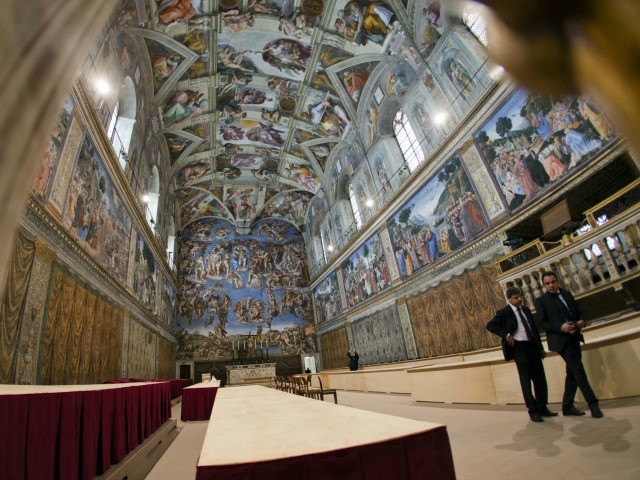
“Disguised in a black robe, Michelangelo hid behind that pillar as his sculpture was unveiled,” the tour guide said. “When he heard one of the Cardinals say that no one would ever believe The Pieta had been sculpted by someone from Florentine, he snuck in that same night and spent hours carving ‘Michelangelo Fiorentino’ into the Madonna’s sash.”

And there it was; his signature on the sash of Mary. And over there was the very pillar a disguised, insecure, proud, and angry Michelangelo had hidden behind. And here I was standing where all of this had happened over 500 years ago.

For some reason, this is when it hit: the very real history of it all. We were at the end of the Vatican tour. A couple of hours had already passed as we passed through astonishing works of Catholic art: sculptures, paintings, frescos… we had passed through the apartments of Popes going back centuries, including “the evil pope,” Alexander VI, aka Borgia. We had even spent 15 minutes looking at Charlton Heston’s amazing work in the Sistine Chapel. But between listening to the tour guide, snapping photos, and all the touristy activity that seems to take away from the actual experience, it was this offhand anecdote that finally brought it all home.
Michelangelo — THE Michelangelo — stood behind that pillar right there. That pillar. That one. I walked over and stood where Michelangelo did. How many others stood here? How many popes and kings and dignitaries and ambassadors and everyday people over so many centuries had stood or trod upon the very spot where I now stood?
The Sistine Chapel will blow your mind, no question. But the climax of the Vatican tour is the Basilica.

Located within Vatican City, St. Peter’s Basilica stands where a church in some form has stood for over 1,500 years. Below is the tomb of St. Peter — one of the original apostles who walked with Jesus. This is not legend. It is history. Even secular historians agree that a man named Peter walked with Jesus of Nazareth. An archeological dig completed just 60 years ago confirmed that a man who lived in the first century AD and died at 60-70 years of age is entombed there. His clothing confirms he was a Bishop — and therefore first in the line of papal succession.
Peter. If it is not Peter, it is a coincidence beyond comprehension.
Until this dig, everyone assumed the Tomb of St. Peter (which we are visiting tomorrow) was merely a symbolic place. Modern archaeology proved otherwise. During the tour, this was a common refrain from our guide: that modern science has turned what had been written off as Biblical legend into fact. Think about that … think about the fact that science is proving, not disproving, my Catholic and Christian faith. This is happening in the Middle East, as well.
I may live long enough to inform Bill Maher that his evangelical atheism is anti-science.
Joking aside, a hundred years ago it would have been much harder for me to embrace Christianity as a faith. The last hundred-or-so years of secular history, science, and archaeology that backs up much of the Old and even more of the New Testament (especially the Gospels) will astonish anyone interested in looking.
Anyway, St. Peter’s Basilica is one of the largest and most beautiful churches in Christendom. Popes are interred there (see below), including Pope John Paul II.

The size is monumental … overwhelming, and the artwork, from floor to ceiling, is impossible to describe.

Near the end of the tour is 20th Century artwork collected by a Vatican still collecting. After experiencing Bernini, Michelangelo, and the others, the “contemporary” stuff looks like the work of pretentious simpletons.
You walk out the front door of St. Peter’s and you are backstage (so to speak), at St. Peter’s Square – where we were yesterday morning to see Pope Francis. The plaza looked even larger from there — which is again a huge contrast from the rest of the city where everything is small.
The complimentary hotel soap is no larger than a half-dollar. A half-Euro is the size of a nickel. Coffee comes in tea cups. People drive scooters, not motorcycles, and a Harley Davidson is larger than most of the cars driven here.
Wine glasses are huge. Prices are gargantuan. Other than that, Rome is Munchkinland populated with normal-sized people.
There are no toilet tanks here. Just a commode. There are two buttons that flush — one large, one small. Romans are somehow capable of knowing which button will do the job — an instinct I have not yet mastered.
It has now been four days since I’ve had a decent cup of coffee, ate a cheeseburger, watched Netflix, or leaned back against a toilet tank. As soon as I return to American, the first thing I intend to do is remedy all four … at the same time.
Other than the language, Roman TV is little different from American TV: Informercials, obnoxious commercials, Pretty Woman, Law & Order reruns. Though I can’t understand what the anchors are saying, the Italian news media looks and feels exactly like ours — so you know they suck.
One plus is that unlike American TV, there is a music video channel that actually plays music videos — American music videos.
P.S. Putting an “a” at the end of all your words is not speaking in Italian. It’s not even close. In fact, rather than appreciate the effort, it makes Italians angry when you do it.

COMMENTS
Please let us know if you're having issues with commenting.